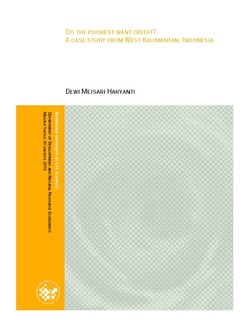| dc.description.abstract | The idea of microcredit being a powerful weapon against poverty has become part of the conventional wisdom in development. The more recent debate is about whether microfinance institutions are reaching the poorest or not, and if they have to give special priority to them. One group stands for prioritization of the poorest as they assume there is vast unmet demand from them; the other argues that the poorest cannot be reached in sustainable basis as there is only limited demand from the poorest. This thesis analyzes assumptions used by the two groups and assesses whether the poorest actually want credit services or not.
This study is based on a survey of 104 low to medium-high class households in Kecamatan Pemangkat, West Kalimantan, Indonesia. As a measure of poverty, it uses 14 welfare indicators constructed by Indonesian Statistics Bureau (BPS). Factor analysis is applied to compress the indicators into only 4 dimensional welfare variables. Together with a set of control variables, this study assesses the effect of welfare (and control) variables on willingness to borrow as an off-market credit demand behavior, and on credit participation as an on-market credit demand behavior using probit models. As an extended analysis, this study also uses the same set of variables to assess household willingness to pay, i.e. the maximum interest rate willing to pay.
There are three major findings of this study. First, what matters for willingness to borrow are not what matters for credit participation. Clothing and asset is found to be the most important variable for credit participation, while possession of business idea is the most important variable for willingness to borrow. The study suggests that supply force is dominating in credit market; therefore in credit participation. Second, the poorest possess the lowest credit demand compared to the other household groups. Therefore, we do not need to target the poorest, not only it is risky from the view of supply side, but also because they actually do not want it. And third, we found that willingness to borrow and willingness to pay are driven by similar variables, thus the findings reinforce each other.
The result of this study suggests that instead of targeting the poorest, microcredit movement can target the poor to accelerate poverty alleviation process. The poor are found to have high credit demand and willing to pay interest as well, but still recording a low rate of credit participation. Credit supplier is suggested to start to consider business idea in evaluating potential borrower’s creditworthiness. In parallel, providing the poor with credit knowledge and education can increase the poor’s creditworthiness and credit participation rate; therefore giving them the key to go out from poverty. | en_US |
